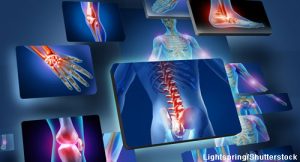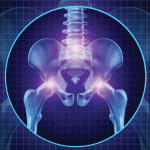Treatment Options for Chronic Pain Stemming from Psychological Stress & Trauma
 Editor’s note: ACR on Air, the official podcast of the ACR, dives into topics important to the rheumatology community, such as the latest research, solutions for practice management issues, legislative policies, patient care and more. Twice a month, host Jonathan Hausmann, MD, a pediatric and adult rheumatologist in Boston, interviews healthcare professionals and clinicians on the rheumatology front lines. In a series for The Rheumatologist, we provide highlights from these relevant conversations. Listen to the podcast online, or download and subscribe to ACR on Air wherever you get your podcasts. Here we highlight episode 39, “The Science Behind Reprocessing Pain,” which aired Oct. 11, 2022.
Editor’s note: ACR on Air, the official podcast of the ACR, dives into topics important to the rheumatology community, such as the latest research, solutions for practice management issues, legislative policies, patient care and more. Twice a month, host Jonathan Hausmann, MD, a pediatric and adult rheumatologist in Boston, interviews healthcare professionals and clinicians on the rheumatology front lines. In a series for The Rheumatologist, we provide highlights from these relevant conversations. Listen to the podcast online, or download and subscribe to ACR on Air wherever you get your podcasts. Here we highlight episode 39, “The Science Behind Reprocessing Pain,” which aired Oct. 11, 2022.
A woman with a history of abusive relationships develops migraines and irritable bowel syndrome early in life. She is later diagnosed with fibromyalgia. Is her traumatic background linked to the development of her chronic pain associated with fibromyalgia?

Dr. Schubiner
Howard Schubiner, MD, an internal medicine physician with Ascension Michigan, Southfield, and founder and director of the Mind Body Medicine Program at Providence Hospital in Southfield, shared with the ACR on Air podcast host Dr. Hausmann how pain can stem from psychological stress or trauma.
Dr. Schubiner, who is the author of Unlearn Your Pain and Unlearn Your Anxiety and Depression, also addressed how pain reprocessing can be used to treat patients living with this type of pain.
Managing chronic pain syndromes can be particularly vexing, noted Dr. Hausmann. “It’s challenging to diagnose [because] there are no specific lab or imaging studies that can confirm the diagnosis, and medications aren’t very effective. [This pain] also causes significant disability to both children and adults,” he said.
These chronic pain syndromes include fibromyalgia or central pain, as well as such associated conditions as irritable bowel syndrome, chronic headaches, chronic fatigue and even chronic pain associated with long COVID.
Although Dr. Schubiner acknowledged that not all chronic pain, injuries or ailments have a psychological source, he said that some do.
A Journey to Lessen Pain
Dr. Schubiner shared what brought him to mind-body medicine and pain reprocessing therapy. His medical work had no connection with pain treatment until about 20 years ago, after he read the work of the late John E Sarno, MD, a physiatrist who wrote Healing Back Pain. Dr. Sarno believed that repressed emotions and psychological stress often caused back pain.
“[Dr. Sarno] didn’t have the science and the studies to prove it; he just had a ton of patient success stories,” Dr. Schubiner said. “He’s being bashed now if you read articles about him, but he was actually right. Science now has confirmed the vast majority of his approach.”
The basic concept, Dr. Schubiner said, is that stress and emotions can cause the same changes in the brain and the body as a physical injury. These changes in people with adverse childhood events or other types of trauma predispose people to conditions, such as anxiety, depression, obesity, heart disease and autoimmune disease.
After reading his books, Dr. Schubiner went to work with Dr. Sarno for a few days. When he returned to his hospital, he offered to start a clinic to treat people with chronic pain. Dr. Schubiner listened to patients and took detailed histories, which many physicians don’t have time to do. By acknowledging that their pain is real—and not dismissing it, which may occur in some other clinical settings—providers can help patients take control of it, he explained.
Dr. Schubiner uses pain reprocessing therapy, which assists patients in perceiving pain signals sent to the brain as less of a threat. As part of this treatment, patients receive help managing emotions that can worsen their pain. He also uses a type of therapy developed at his center called Emotional Awareness and Expression Therapy.1 This approach targets the underlying emotions that may trigger pain and other symptoms.
Working with Patients
Before seeing a patient, Dr. Schubiner asks them to do some research to understand pain reprocessing therapy and his approach.
“I’m not trying to convince [patients] of something. I want to investigate with them and that gets into our diagnostic approach,” he said.
He also rules out any structural or lab-related problem that can be found on imaging or through an exam as a source of pain. Even if there is some normal, age-associated structural damage seen via imaging, Dr. Schubiner will ask questions to pinpoint the behavior of the patient’s pain, such as, “Does the pain move around or change based on cold, heat or other environmental factors?”
Next, he addresses the question of whether symptoms began and may be associated with specific life events.
Dr. Schubiner shared the story of a young woman with sacroiliac joint pain that started in May one year and then went away. This pain came back the following May. He asked her and her father if anything happened in May that affected her life. At first, the answer was no.
“I just waited, and a tear rolled down this girl’s cheek and her dad’s cheek,” he said. “Her sister had died [during] the month of May the year prior.”
When working with patients, Dr. Schubiner explains the connection of pain coming from the brain. “When you think of it that way,” he said, “the pain that occurs that’s due to stress or emotions, it’s exactly the same and every bit as severe as pain that occurs with a kidney stone or fracture.”
Results of Pain Reprocessing Therapy
To help patients with psychological-related pain, Dr. Schubiner advises the use of pain reprocessing therapy to help people decrease their fear and calm their brain to change its neural circuits.
Dr. Schubiner shared the results of a randomized clinical trial he coauthored published in JAMA Psychiatry in 2022.1 In the study, 151 adults with chronic back pain (i.e., pain symptoms lasting more than 10 years) and a patient-reported pain intensity rating of 4 out of 10 were randomized into three treatment groups: pain reprocessing therapy, a saline injection in the back (placebo) or their usual, routine care.
Patients in the pain reprocessing group had eight psychological treatment sessions over four weeks. The sessions were designed to “reconceptualize their pain as due to nondangerous brain activity rather than peripheral tissue injury, using a combination of cognitive, somatic and exposure-based techniques,” according to the study.
After the treatment, the mean pain score was 1.18 for the pain reprocessing therapy group, 2.84 for the placebo group and 3.13 for the usual care group. Among the 50 participants randomized to undergo pain reprocessing therapy, 66% of patients were pain-free or nearly pain-free post-treatment compared with 20% of patients in the placebo group and 10% of those in the usual-care group.
The study received funding from the U.S. National Institute of Health’s National Institute on Drug Abuse, the National Institute of Mental Health and the National Center for Advancing Translational Sciences.
Additional Treatment
Many of Dr. Schubiner’s patients also work with therapists, but may find physical and psychological support from other clinicians. This approach works most effectively if that professional has training in and understanding of central pain, he noted.
Not all patients will be successful using this pain management approach, he said. Some patients don’t fully believe in the treatment, which can affect its results. Other patients may have ongoing issues in their life or severe childhood trauma that affect their ability to reprocess pain.
Dr. Schubiner said such treatments as cognitive behavioral therapy, acceptance and commitment therapy (a type of psychotherapy) and mindfulness are helpful, but with a caveat. “[Those treatments] start from the premise that [they] will help you cope with your pain and live with it better, and people don’t really want that,” he said. “They want to get better.”
Resources

Dr. Hausmann
Dr. Hausmann wondered if rheumatologists should lead the charge with helping certain patients, including some with fibromyalgia, reprocess their pain.
“I think it’s not so much the [specialty], it’s the interest,” Dr. Schubiner said, noting that he had a rheumatologist who was also finding ways to make extra time for chronic pain patients go through one of his training programs. However, if a clinician doesn’t have an interest, it won’t work as well.
Both clinicians and patients interested in learning more about the mind-body approach and pain reprocessing can explore resources on Dr. Schubiner’s website and elsewhere (see sidebar below).
Vanessa Caceres is a medical writer in Bradenton, Fla.
Reference
- Ashar YK, Gordon A, Schubiner, H et al. Effect of pain reprocessing therapy vs. placebo and usual care for patients with chronic back pain: A randomized clinical trial. JAMA Psychiatry. 2022 Jan 1;79(1):13–23.
Resources
Clinicians and patients interested in learning more about the mind-body connection and pain reprocessing can explore Dr. Schubiner’s website and the following resources:
• Dr. Schubiner’s Mind-Body Medicine;
• Videos on the mind-body connection (available in English and Spanish);
• Psychophysiologic Disorders Association;
• Michigan State University course: Reign of Pain; and
• Curable Health: An app to guide people in recovery from mind-body disorders.
More Episodes
A new episode of ACR on Air comes out twice a month. Listen to this full episode and others online at acronair.org. Or download and subscribe wherever you get your podcasts.

